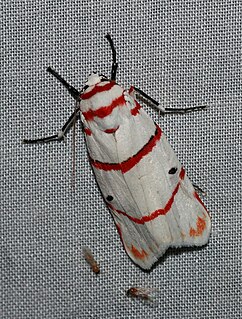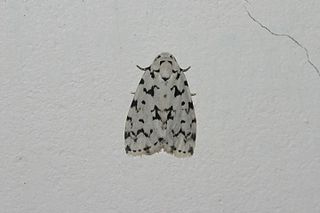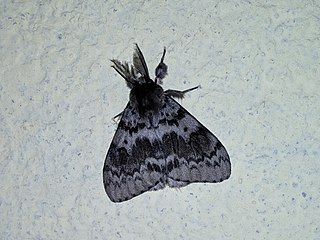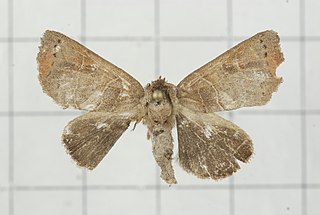
Cyana is a genus of moths in the family Erebidae. Species are well distributed in Africa, Madagascar, China, India, Sri Lanka, Myanmar, Sumatra, Java and Borneo. The genus was erected by Francis Walker in 1854.

Nepita is a monotypic moth genus in the subfamily Arctiinae described by Moore in 1860. Its only species, Nepita conferta, the footman moth, was first described by Francis Walker in 1854. It is found in India and Sri Lanka.

Cyana puella is a moth of the family Erebidae. It is found in the north-western Himalayas, Nepal, India, Sri Lanka, Madagascar, Kenya and Eritrea.

Cyana peregrina is a moth of the family Erebidae. It is found in India and Sri Lanka. The habitat consists of forests.

Cyana effracta is a moth of the family Erebidae first described by Francis Walker in 1854. It is found in Nepal, the north-eastern Himalayas, Taiwan, China, Burma, Peninsular Malaysia, Sumatra and Borneo.
Scopula emissaria is a moth of the family Geometridae. It was described by Francis Walker in 1861. It is found in India, Sri Lanka, Myanmar, Vietnam, China, Korea, Japan, the Philippines, Sumatra, Java, Wallacea and Australia.

Eressa confinis is a moth of the family Erebidae. It was described by Francis Walker in 1854. It is found in India, Bhutan, Sri Lanka, Myanmar, Taiwan and China.
Nyctemera latistriga is a moth of the family Erebidae first described by Francis Walker in 1854. It is found from the Oriental tropics of India, Sri Lanka, Myanmar, Andaman Islands, Sumatra, Borneo to the Philippines and Lombok.
Padenia transversa is a moth of the subfamily Arctiinae. It was described by Francis Walker in 1854. It is found in Sri Lanka and on the Andamans.

Aemene taprobanis is a moth of the family Erebidae. It was described by Francis Walker in 1854. It is found in China (Li-Kiang), the north-western Himalayas, India, Sri Lanka and Malacca.
Rajendra biguttata is a moth in the family Erebidae. It was described by Francis Walker in 1855. It is found from southern India to north-eastern India and in Bangladesh and Sri Lanka.

Scaptesyle bicolor is a moth in the subfamily Arctiinae. It was described by Francis Walker in 1864. It is found in Sri Lanka, Assam in India and Taiwan.
Deltoplastis amicella is a moth in the family Lecithoceridae. It was described by Francis Walker in 1864. It is found in India (Assam), Myanmar and Sri Lanka.
Cyana detrita is a moth of the family Erebidae first described by Francis Walker in 1854. The male has a wingspan of 15 mm and the female's is 19 mm.

Lymantria incerta is a moth of the family Erebidae first described by Francis Walker in 1855. It is found in India and Sri Lanka.

Clostera restitura is a moth of the family Notodontidae first described by Francis Walker in 1865. It is found in Oriental tropics of India, Sri Lanka, and from Hong Kong to Sundaland.

Hipoepa biasalis is a moth of the family Noctuidae first described by Francis Walker in 1859. It is found in Oriental tropics of India and Sri Lanka to Taiwan, Sumatra, Borneo, the Philippines and Sulawesi.
Altha subnotata is a moth of the family Limacodidae first described by Francis Walker in 1865. It is found in Sri Lanka, India and Nepal.
Lasiolopha saturata is a moth of the family Nolidae first described by Francis Walker in 1865. It is found in Oriental tropics of India, Sri Lanka, Thailand, New Guinea and Australia.

Earias cupreoviridis, called the cupreous bollworm as a larva, is a moth of the family Nolidae. The species was first described by Francis Walker in 1862. It is found in African countries like Botswana, the Democratic Republic of the Congo, Eritrea, Ethiopia, the Gambia, Kenya, Nigeria, Sierra Leone, South Africa, Togo, Uganda, Zimbabwe to Asian countries like India, Sri Lanka, China, Japan, Korea, Philippines, Indonesia and Hong Kong.











